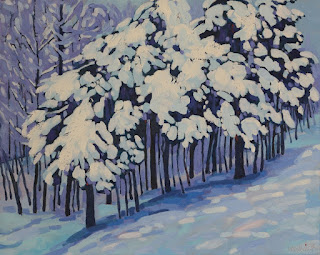 |
#2616 "Singleton Thoughtful Sunset"
11x14 inches |
The sunset from 5:55 pm Sunday February 6th, 2022 was special and very dramatic. The winter was progressing beautifully. It was a real Canadian winter in the cold trough of climate change. There was a lot of snow and wind. This sunset gave me some quiet time to really think. Please let me explain.
Extreme global warming is very real and far from uniform. Some places are actually cooler in specific seasons - at least for a while. This is the case for eastern Ontario. Conservation of angular momentum and the Rockies collaborate to create a large and durable trough of low pressure over eastern Canada - especially in the winter. This pattern is also more common all year long and is the reason we retired in eastern Ontario and not on the west coast like many of my former colleagues. Eastern Ontario will benefit from cooler temperatures and precipitation while the west coast will get hot and generally drier under the upper ridge. The increasing temperatures allow more water vapour to be held in the atmosphere. This heat and moisture are fuel for more severe and dynamic storms.
 |
| British Columbia, Fall 2021 |
Atmospheric rivers which I wrote about for
COMET in a 2009 educational module, is one example of a water vapour plume that can be locked in on relatively small geographical areas. The weather is nature's way to try to maintain a balance of heat, cold, moisture and even electrical charge around the globe. These atmospheric rivers can change a drought into a flood in the matter of hours as was witnessed in southern British Columbia in the fall of 2021 with devastating impacts.
February 2022 was the sixth warmest February on record. While Europe, Middle East and Russia were very warm, North America was widely cold. Canada was especially cold.
The Southern Hemisphere had weaker anomalies compared to the Northern Hemisphere. Cool Australia stands out and warm central south America. A very noteworthy record low Antarctic sea ice extent was set. The Arctic and Russia really stand out as the hotpots. Some places average more than 7°C warmer than the 1981-2010 average.
These images are courtesy of my friend Scott Duncan, a talented, professional meteorologist who does terrific work communicating weather and climate through these engaging graphics.
This Singleton sunset gave me much to ponder...
For this and much more art, click on Pixels. Thank you.



















































